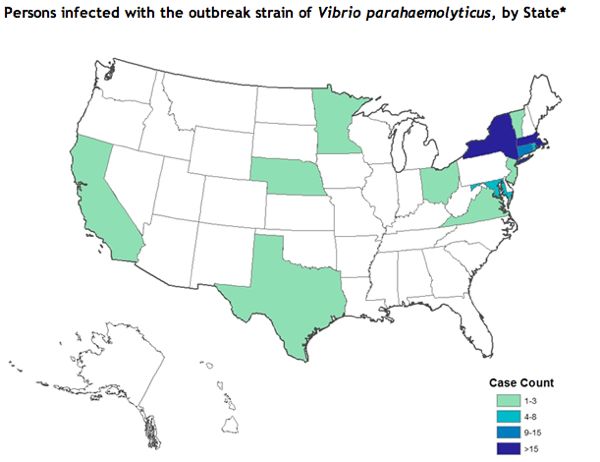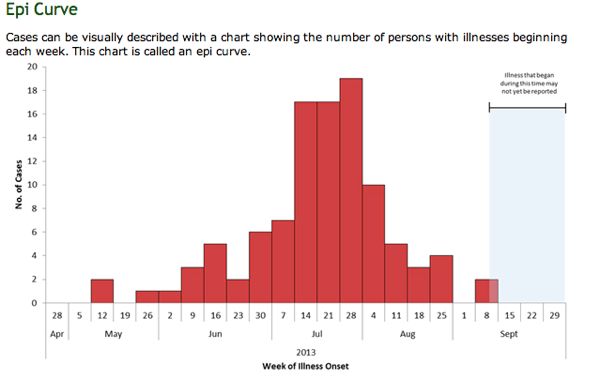But Don’t Worry – The Christie DEP Is On A “Barnegat Bay Blitz”
[Update below]
What, with all the recent good news about the EPA Beach Bacteria Monitoring Guidelines, the Christie DEP’s Barnegat Bay Blitz, and all the coastal group opposition to climate change research (aka “The Seismic Smokescreen”) perhaps you missed this story.
I certainly don’t recall seeing it in NJ news reports.
No biggie – it’s just about 2 recent cases and the increase of an outbreak of potentially fatal flesh eating bacteria that live in polluted, nutrient rich, warm coastal waters and bays near you.
Last week, CBS news reported (watch) “Experts Warn About Flesh Eating Bacteria in Chesapeake Bay“
Reuters now reports a second DC case:
(Reuters) – A flesh-eating bacterial disease has infected another Washington, D.C.-area man, local media reported on Thursday, just days after a man was released from a hospital following a near-deadly bout with the germ.
Joe Wood of Stafford, Virginia, said he was swimming in the Potomac River near the town of Callao earlier this month when a scratch on his left leg became infected with vibrio vulnificus, an aggressive bacteria that feeds on flesh, Washington D.C.’s WTOP radio reported.
I don’t want to be an alarmist – and I certainly wouldn’t want to scare away any tourists, which is Taboo in Trenton no matter what the science says! – but vibrio bacteria are found in warm nutrient pollution enriched NJ waters, particularly Delaware Bay and Barnegat Bay.
The vibrio bacteria blooms and disease outbreaks from exposure are associated with warm summer water temperatures, just when people are swimming, recreating and eating potentially contaminated shellfish – a phenomenon sure to get worse as pollution increases and climate change warms coastal waters.
So, I thought I provide some important information.
Here is the Center for Disease Control website.
Here is scientific research on Barnegat Bay vibrio population dynamics, where researchers found (these are verbatim quotes):
- occurrence of vibrio [has been] linked to temperature, salinity, and nutrient status of water
- Vibrio community size was strongly correlated with temperature
- analysis showed that Vibrio populations are present year round in Barnegat Bay, with elevated population sizes during summer.
- These warm-ocean populations contain sequences closely related to noted pathogens of humans and marine fauna.
- populations dominating the summer Vibrio community of Barnegat Bay are highly related to tropical strains
- [vibrio strains] includ[e] campbellii & the noted food-borne human pathogen parahaemolyticus, & Vcarchariae, an agent of disease …& human wound infections
A 2009 Report from our friends at the Chesapeake Bay Foundation warned:
VIBRIO The combination of warmer waters, nutrient pollution, and other factors in the Chesapeake Bay are contributing to the growth of bacteria called Vibrio that can cause life-threatening skin and blood infections and intestinal illnesses, according to Dr. Rita Colwell, former director of the National Science Foundation and current Distinguished University Professor at the Johns Hopkins Bloomberg School of Public Health and University of Maryland, College Park. Although infrequent, the number of annual Vibrio infection cases reported in both Virginia and Maryland has increased in recent years. In Virginia, the number has more than doubled over the last decade, from 12 in 1999 to 30 in 2008. Reports of infections have also risen in Maryland, but a change in reporting requirements in that state in 2003 complicates the picture there. In both states, it is unknown how many of these cases come from eating or handling shellfish from other regions. Nutrient pollution is nitrogen and phosphorus from many sources, including stormwater runoff from streets, farm fields, barnyards and lawns; discharges from sewage plants, septic tanks and industries; and air pollution from power plants, factories and vehicles that settles into the water.
CYANOBACTERIA Nutrient pollution and warmer weather also stimulate the growth of harmful algal blooms. Blue green algae, also known as cyanobacteria, can cause liver disease, skin rashes, nausea, and vomiting. Dr. Peter Tango, Chesapeake Wa- tershed Monitoring Coordinator for the U.S. Geological Survey, recently co-authored a report that called harmful algal blooms a “significant and expanding threat to aquatic life, human health, and regional economies.” Between 2000 and 2006, Dr. Tango tested waters with cyanobacteria blooms and found that 31 percent had enough toxins to make the waters unsafe for children to swim in.
CRYPTOSPORIDIUM During the summer, polluted runoff, animal waste, and sewage often create high bacteria levels at swimming beaches. In the Chesapeake Bay watershed, Pennsylvania had 22 closures at 17 swimming areas last summer; Maryland had 44 no-swimming advisories or closures at 31 beaches during the same period; and Virginia had 10 advisories at 6 beaches. But even these numbers might not reflect the true prevalence of pathogens at beaches, according to a Johns Hopkins Bloomberg School of Public Health researcher. Dr. Thaddeus Graczyk has concluded that local health departments don’t test swimming areas often enough, thoroughly enough, or quickly enough to protect the public. A study by Dr. Graczyk found the dangerous protozoan pathogen Cryptosporidium (which local health departments do not test for) at levels that could infect people in 70 percent of weekend samples at a Baltimore County beach.
So, be careful out there people!
[Update – Oh, I almost forgot to mention that the EPA Beach Bacteria Monitoring Guidance you’ve heard so much good news about from the various cheerleaders out there, does not consider vibrio (a bacteria).
It explicitly rejects vibrio as a “native” bacteria, and puts exclusive emphasis on fecal sources and strains of bacteria.
But I don’t think those infected flesh wounds know the difference between native and human source bacteria. – end update]



Pingback: 私たちのオンラインストアで格安販売
Pingback: 割引価格と高品質!
Pingback: 安い価格のために、100%本物の革、世界中送料無料
Pingback: 607OFF
Pingback: 品質の良いスタートを切る
Pingback: アウトレットオンライン販売
Pingback: 私たちのディスカウントショップで
Pingback: オンラインショップ
Pingback: 大きい割引と世界中へお届けしますオンライン。
Pingback: 優れた品質と高速へお届けします
Pingback: 送料無料
Pingback: バーゲンブラスト
Pingback: より多くの割引を取得し、オンラインショップアウトレット
Pingback: アウトレットオンラインショップはあなたのために良い選択である
Pingback: 販売サイト【送料無料】
Pingback: オンラインショップ
Pingback: 送料無料、世界であなたはとても魅力的に
Pingback: オンライン
Pingback: 私たちのオンラインストアで販売中
Pingback: 高級品オンラインストアで
Pingback: オンラインで購入方法
Pingback: 高級品店の販売
Pingback: Outle
Pingback: 私達は行くことができますどのようにローを参照してください。
Pingback: 公式ストアで
Pingback: 販売店舗
Pingback: クーポンコード
Pingback: 65%を保存すギ
Pingback: 保証商品&24時間365日オンラインサービス!
Pingback: 一週間お届けます。
Pingback: 私たちは、最高の品質と低価格を提供
Pingback: オンライン
Pingback: 販売サイト【送料無料】
Pingback: 割引80%オフまょ
Pingback: 本物のアウトレット
Pingback: 米国の販売
Pingback: アウトレットセール
Pingback: 今、これらの価格を活用する
Pingback: 私たちのオンラインストアで格安販売
Pingback: 65%を保存すろ
Pingback: 65%を保存す゜
Pingback: 最高品質お届けします
Pingback: 、すべての製品は無料送料無料を楽しむ
Pingback: プロのデザイン割引でお好みの愛
Pingback: 世界中の発送、70%までセーブ
Pingback: オンライン
Pingback: 澶氬疂骞冲彴
Pingback: cheap ray bans
Pingback: hogan rebel limited edition
Pingback: new balance 507